Reader Feature: Leslie Ann Bestor
Tell us a little bit about yourself and how you got started spinning.
Basically, I tricked myself into learning to spin. My first fiber love was knitting, and I followed that bliss and focused on learning, making, and teaching for years. Then I picked up weaving, which was like coming home to me, and I became devoted to learning and exploring it deeply. I resisted the siren’s call of spinning for a long time, convinced it would take away from my weaving and add a second learning curve when I really just wanted a singular focus on my weaving.
And then Spinzilla happened. I had just become Weaving Manager at WEBS yarn store and ignored the call for a team captain until it became apparent the spinners were too busy to take it on. I didn’t spin, but I recognize a fun competition when I see it and volunteered, thinking my organizing and cheerleading skills could lead the day. Then, as the event came closer, I realized it would feel weird to be exhorting my teammates to “spin more!” and “faster!” when I wasn’t adding to the team total. So a weaving guildmate taught me to spin, and I made lumpy yarn with much encouragement from my teammates and fell in love both with spinning and the community of spinners.
Of course, spinning lives up to my worst fears: it competes with weaving for my time and money, adds another type of fiber stash to an already packed house, needs more tools – and it soothes my soul and, ironically, has opened a whole new style of weaving to me.
Do you have a favorite type of yarn to spin?
I have a fondness for the sheepy things; I love the sproing and bounce. But then I took a silk spinning workshop last August (2019) and became entranced. I declared 2020 to be the Year of Silk and decided to focus on learning and experimenting and trying new things with silks and silk blends. It feels so indulgent and luxurious to work with, yet it is strong and has that wonderfully long staple.
What do you like to make with your handspun yarn?
For a long time I was definitely a process spinner – my joy was in the time spinning and the finished yarn was an afterthought waiting for a suitable project to show up. In the past couple of years, I’ve come into making intentional yarn, creating the yarn I envision for a project, usually weaving. I’ve been weaving a series of wide scarves on my rigid heddle loom, mixing my handspun with a commercial weaving yarn to create warp-dominant pieces that showcase the handspun. This has been a lot of fun, especially with the silks and silk blends.
My other favorite reason to spin is for gift giving. Many of my friends and family create things from yarn, and I love to surprise them with something special – a luxe blend or amazing colorway. And then I get to indulge myself, too, in the spinning process.
How long have you been reading PLY?
Since I started spinning in 2014. Spinning friends who mentored me raved about it, and I could see why. I fell in love with the simple beauty, the eye candy, and as I learned to spin, I learned more and more from the articles. I have many issues in my bookcase, they are my reference library and resource guides, and a couple that I bought digitally (the Silk issue is pretty much open on my laptop all the time these days).
What do you look forward to most when you get an issue?
An afternoon/evening of relaxation, inspiration, and education! I get myself a beverage and settle into a cozy corner to pore through it. Admire the front cover and see what Jacey has to say, scan the contents and see if anything jumps out, and then begin a long perusal. Sometimes it’s a brief once-through with an eye to coming back to certain things. Other times, when I have the time, I devour the articles as I go. After it lolls around the house for a few weeks, it goes on the shelf with the others, ready to refer to for guidance or inspiration. They feel pretty timeless to me.
Tell us about a project you worked on that was inspired by an article, project, or issue of PLY.
Since I have been raving about silk, you can guess that my favorite issue of PLY is the Silk one. Once I took the silk spinning class, I bought the issue digitally and consumed it, rereading articles several times. I wanted to learn more about different kinds of silk, and 2 of the articles got my interest. The first was an experiment with multiple types of silk comparing luster and direction of spin/ply which seemed like a great way to try the different types of silk. The second was a project to make what the author called a deconstructed cowl. It was colorful and playful and involved an assortment of fiber preps, so here was another great way to learn about the varieties of silk. When I declared 2020 the Year of Silk, I got ready for it by seeking out and buying all the soft and shiny bits for these 2 projects.
When the pandemic came along I thought spinning would be my salvation, relaxing and calming me as usual. But when I tried my default yarn, the mindless kind I thought would be soothing with its regularity, my mind just raced with anxious thoughts. I realized I needed something to help me focus my mind, which learning some new will do, but I didn’t want to add stress; I needed something fun. Immediately I thought of the deconstructed cowl, and here is how it went:
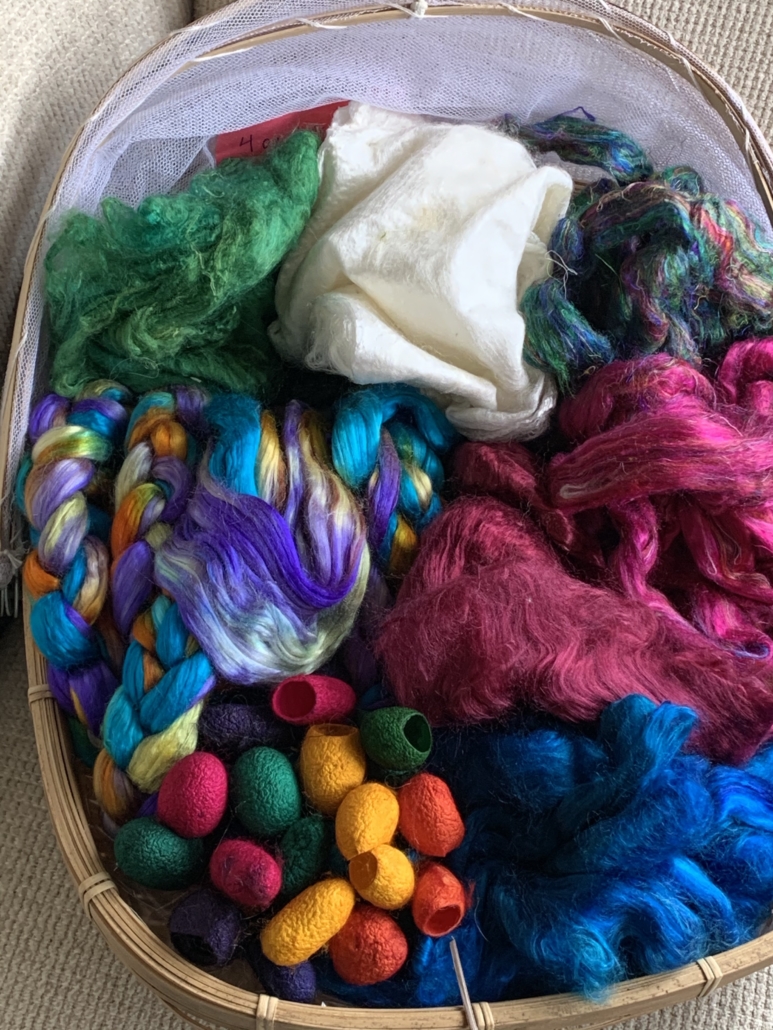
I had some of the supplies already and then bought the rest to go (nominally) colorwise with them. I looked for the brightest, most cheerful colors I could find. I filled my basket with bombyx brick, hand painted bombyx combed top, hankies, cocoons, sari waste, and more random bombyx top. I set the basket next to me while I was spinning the single and chose randomly what to spin next.
This part of the project was so delightful! I put no pressure on myself to make perfect yarn, and since the project was a bit wacky, it was all going to look crazy anyway. At the same time, I was focused on learning to work with the fibers, so my mind was occupied with what was in my hands rather than what was in the world. This spinning was definitely my happy place: the colors were fun, I got to keep changing it up, there was no wrong way, and – the shiny!
I spun the top and the brick over the fold with a short forward draw and the sari silk with a short forward draw; the hankies I drafted out and just added twist at the wheel (Lendrum double treadle with jumbo plyer).
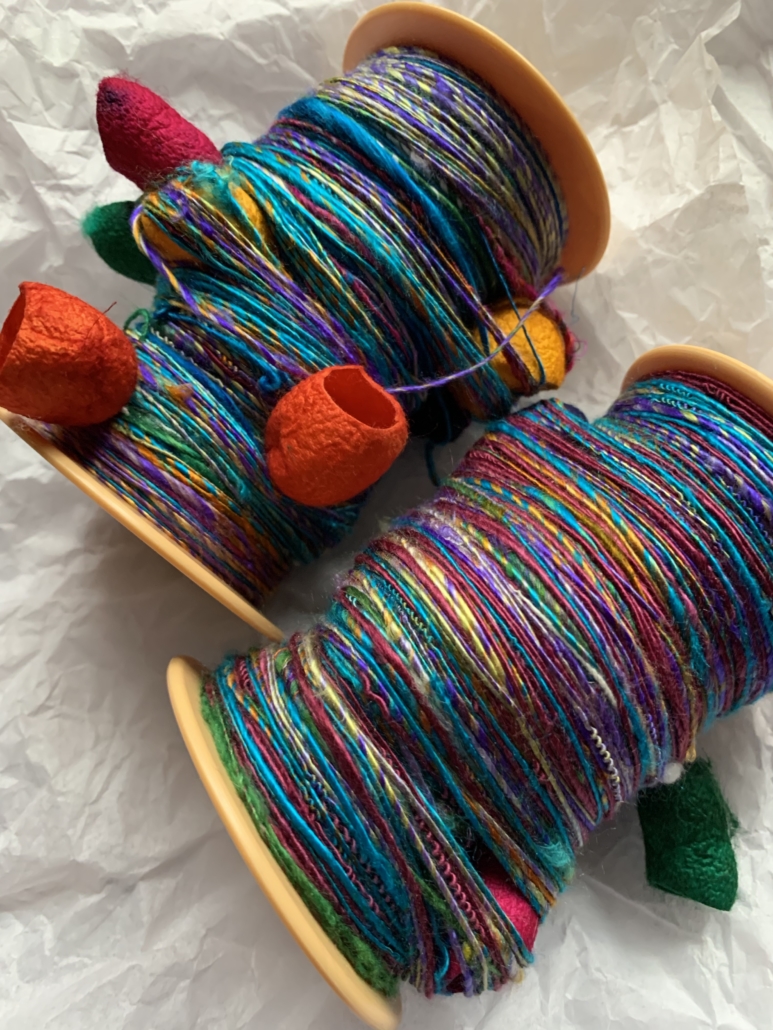
The second step involved coiling the single around a core (I used 10/2 cotton, a weaving yarn). I had never done coils before and certainly never saw myself spinning an art yarn (how did I get here?), but the pictures in the article were so clear and precise that it was easy to pick up. To be honest, I’m not sure I got it right, but the end result works; it looks like success to me. The coiling was fun, too, kind of like holding the reins on a cantering horse. Of course, that would be a carousel horse because it was so brightly colored, and then there were these cocoons dangling like little bobbles! I posted pictures to my spinning group, and a friend dubbed it Seuss-like, a comparison I love.
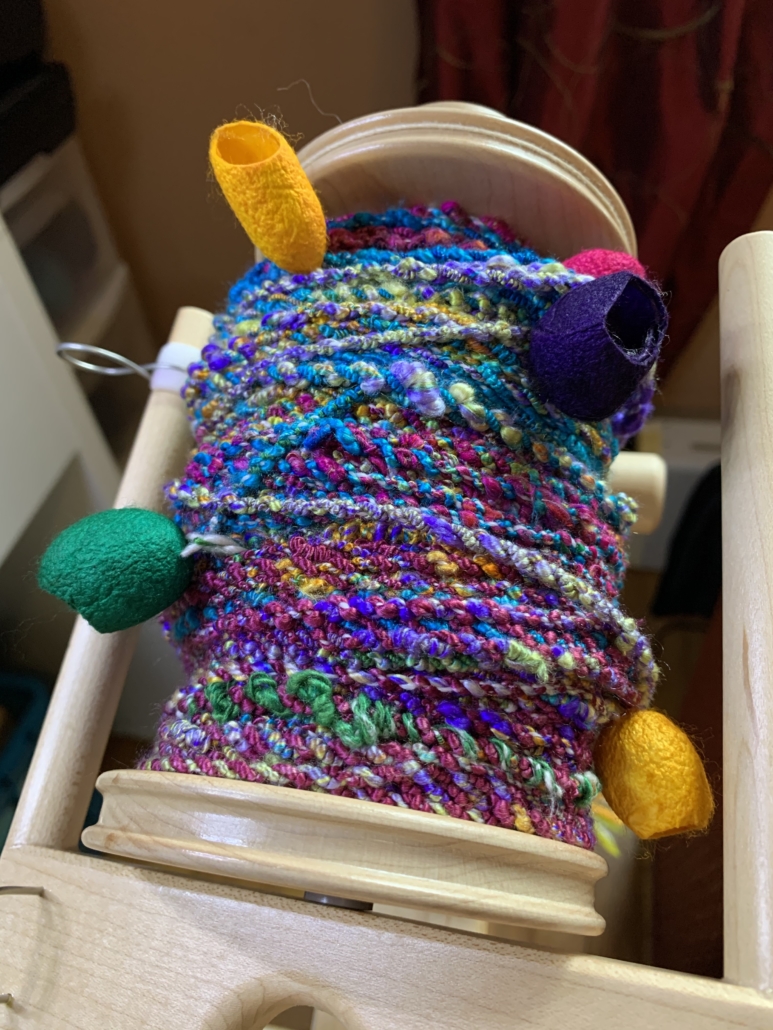
I did change things up when I had a break in my coiled yarn which allowed me to do the plying from 2 separate bobbins rather than trying to wind a plying ball, which sounded tricky. Of course the bobbins weren’t even, but I realized the leftover coiled yarn makes a perfect necklace.
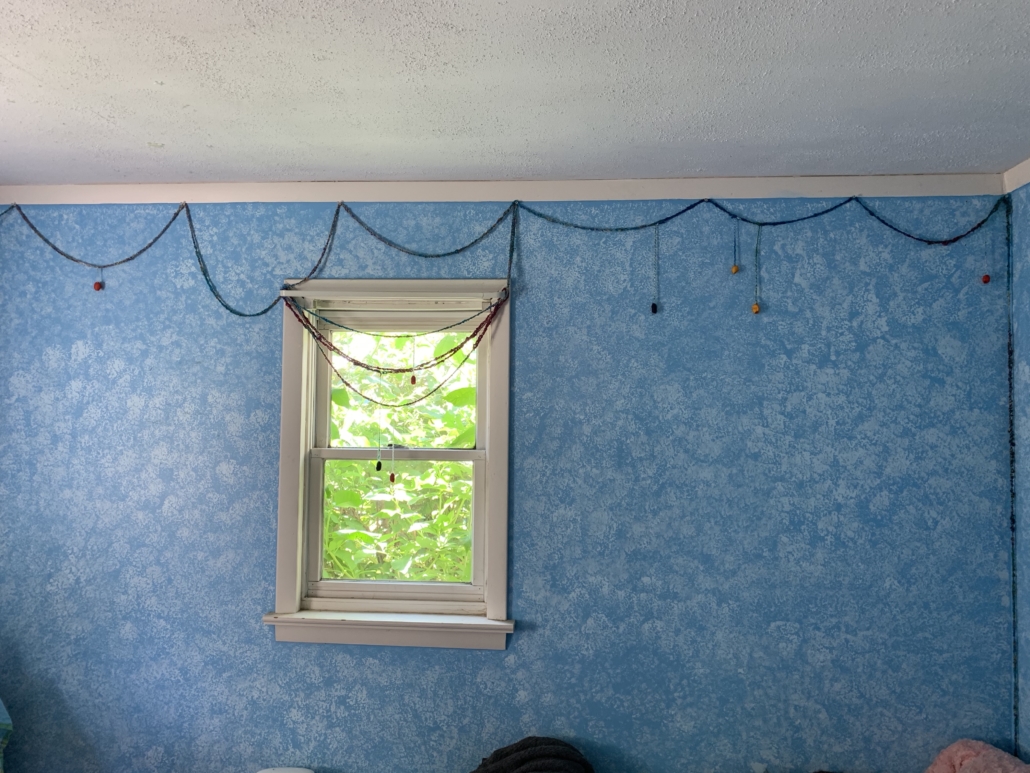
The last step was to crochet this twisted and plied colorful cord. I wound the plied yarn onto my swift and worked from the swift to crochet what I now call the Seussian Silk Garland. It is heavy and shiny and has these dangly colorful cocoons. I wish I were living in my parents’ house with their big bay window because that would be the perfect place to hang this garland, as a swag that would sparkle and shine in the sun. For now, I have my garland draped around the walls of my bedroom, very renaissance in a Seussian way. It will be my goofy garland of the pandemic, a symbol of joy and learning shining through.
Epilogue: I have started my second PLY pandemic project, the study of spin/ply twist direction on luster. I am proceeding slowly, as I apparently need breaks for wild color, but I’m learning a lot as I work through the different varieties of silk.
Leslie Ann Bestor can be found on Ravlery as carpeyarnum and Instagram @leslieannbestor.
If you’d like to participate in an upcoming reader feature, fill out the reader feature form and Karen will contact you.
PLY Magazine believes that Black lives matter, as well as LBGTQI+ lives. Those most vulnerable and persecuted in our communities deserve our love and support. Please be good to each other.

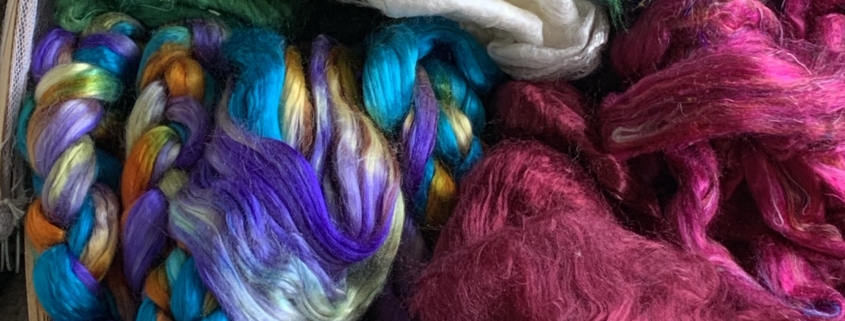
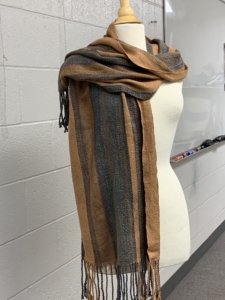
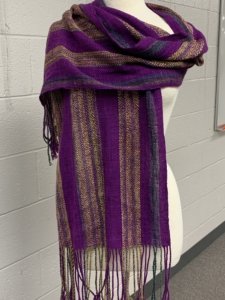


Leave a Reply
Want to join the discussion?Feel free to contribute!